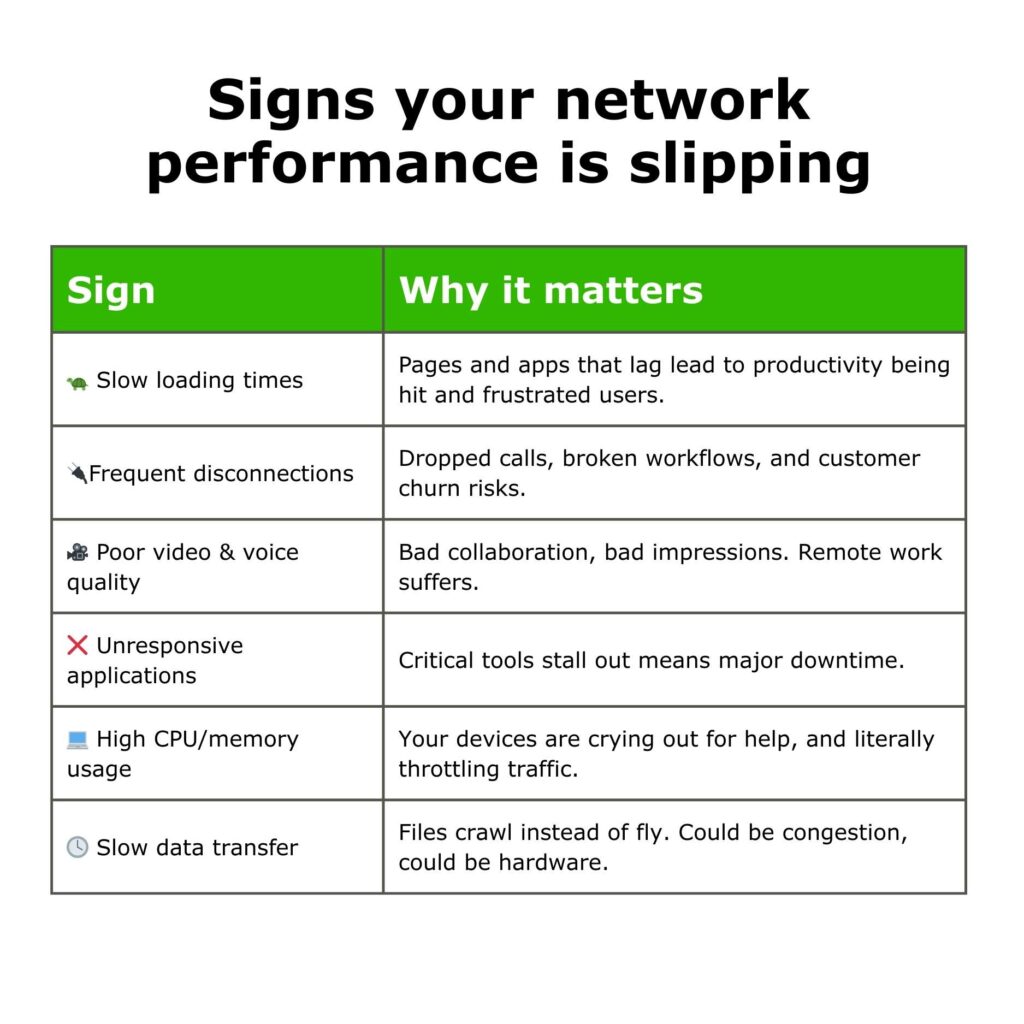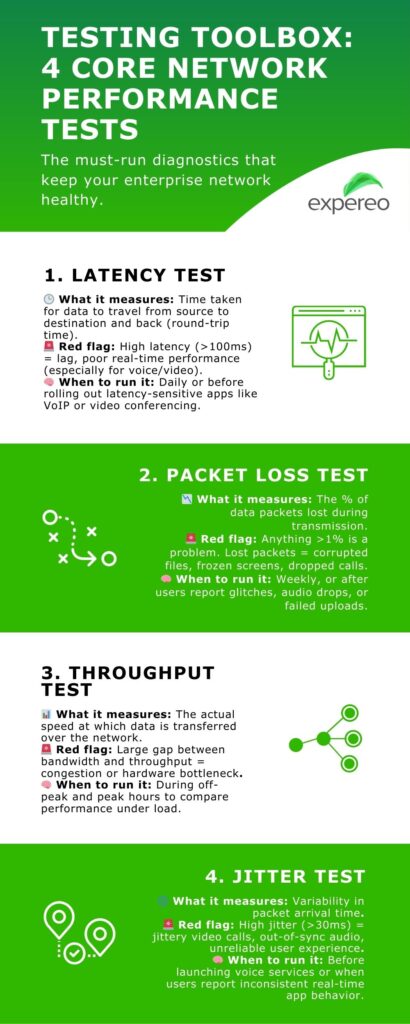
November 12, 2024 | 12 minute read
How to improve network performance
With hundreds, if not thousands, of users on your global IP network, your network’s reliability and speed will affect everything. From employee productivity to customer satisfaction. With increasingly complex infrastructures, cloud-based applications, and growing user demand, enterprises need to improve network performance more than ever before.
Additionally, the more performance metrics you can gather about your network, the better you’ll be able to improve its performance. However, there are some challenges to understanding your network’s performance that can hinder network efficiency.
What is network performance?
When we talk about “network performance”, we’re referring to how well a network supports the desired operations and services needed by both internal and external users. This can mean anything from how well your employees can access your cloud-based applications, to how well your customers can access your websites and services.
The main elements that give a good indication of how fast and reliably your data moves across your infrastructure are:
- Network speed.
- Bandwidth usage and bottlenecks.
- Latency
- Packet loss
- Jitter.
Signs of poor network performance

Poor network performance can be felt across a global enterprise. Identifying any issues early is crucial for preventing downtime, maintaining productivity, and safeguarding against potential revenue loss.
Here are some common signs of poor network performance to monitor:
- Slow loading times: If web pages or applications are taking too long to load, it’s a clear sign your network isn’t running optimally.
- Frequent disconnections: Repeatedly losing connections can be a major disruption to both employees and customers, indicating instability in the network.
- Poor video and voice quality: If you experience frequent distortions, interruptions, or lag during video calls or streaming, your network performance is likely to blame.
- Unresponsive applications: Cloud-based or SaaS applications can become unresponsive when the network is struggling, affecting employee productivity.
- High CPU or memory usage: Network devices like routers and switches can get overwhelmed. Leading to throttled network speeds and dropped connections.
- Slow data transfer: That means file transfers, downloads, and uploads may be delayed, or there may be extended wait times.
The cause of poor network performance can come down to several factors. You need to understand the current layout of your network components, the types of hardware and software you’re using, and what your baseline network traffic is with network testing.
Network performance testing
Testing network performance regularly is important so that you know what good looks like for your network. It also allows you to quickly identify immediate issues, and can identify areas of improvement long-term. It involves analyzing how your network behaves under different loads and identifying bottlenecks.

Some key methods for network performance testing include:
- Ping tests: Ping measures the round-trip time (RTT) of a packet from the source to the destination and back, offering insights into latency.
- Bandwidth tests: These tests measure the amount of data your network can transfer within a set period, ensuring your bandwidth matches your business requirements.
- Packet loss tests: These tests measure the percentage of data packets that are lost in transmission. This can point to hardware issues, congestion, or software misconfigurations.
- Speed tests: Speed tests evaluate both upload and download speeds, helping to assess whether your network can support high-demand applications like video streaming or large file transfers.
Doing regular tests will allow you to understand what your baseline performance is. If you have good performance, you only need to react to issues as they arise. But if your baseline performance is poor consistently, you should consider making proactive improvements to your network infrastructure.
It’s also important to understand what your usage patterns are, when there will be peaks periods lows. For example, eCommerce companies’ networks need to be able handle the significant increase in bandwidth needed for Black Friday or similar events.
Network performance monitoring definition
Moving on to network performance monitoring, you may wonder how is it different from network performance testing?
Network performance testing evaluates how a network operates under controlled conditions by measuring metrics like speed, latency and packet loss, etc. While testing can be done regularly, it’s not done every day. In contrast, network monitoring continuously tracks real-time network health and performance to detect issues and ensure optimal operations over time.
Network performance monitoring (NPM) ) is the constant process of observing, tracking, and analyzing the performance of your network infrastructure. The goal is to ensure optimal network health and proactively address issues before they impact end-users. You can also use it to understand how your network resources are used. So you can reallocate them accordingly or reconfigure the network to accommodate more usage.
There are many network monitoring tools that can help you spot potential problems like bottlenecks, misconfigurations, or hardware malfunctions that could slow down operations or disrupt communication.
Network performance metrics to watch
We’ve touched on this briefly , but measuring the right network performance metrics is essential for identifying and addressing issues quickly.
Here are the most important metrics to monitor with performance monitoring tools:
- Latency: Latency refers to the time it takes for a data packet to travel from one point to another in the network. High latency can result in lagging applications and poor user experiences. These are particularly important in the modern work environment where video conferencing plays an important role for employees working both from the office or at home, or collaborating with global teams.
- Packet loss: Packet loss occurs when data packets traveling across the network fail to reach their destination. This results in incomplete data transfers and can cause serious issues for VoIP calls, video streams, or online transactions.
- Network jitter: Jitter refers to the variation in packet arrival times, which can disrupt real-time applications like video and voice communications, which are very important today. High jitter can cause delays, echoing, or poor audio quality during calls.
- Network availability: Availability measures whether your network and its services are accessible to users at any given time. A high availability percentage means your network is online and functioning as expected, while downtime can point to system failures, configuration errors, or hardware issues.
- Round Trip Time (RTT): RTT is the time it takes for a data packet to travel from the source to the destination and back. It’s a critical metric for measuring the responsiveness of your network and can help diagnose potential delays or bottlenecks.
Additional network performance metrics to watch
- Network error rate: Error rates track the number of errors in transmitted data, including corrupted packets or incomplete transmissions.
- Data transfer rate: This metric measures how much data is transferred across the network in a specific period. It’s critical for assessing whether your bandwidth is sufficient to handle the demands of your applications and users.
- Mean Opinion Score (MOS): MOS evaluates the quality of voice and video communications on a scale from 1 (bad) to 5 (excellent). A low MOS score indicates poor audio or video quality, which is often caused by high latency, jitter, or packet loss.
- Network congestion: Congestion occurs when too much traffic overloads network capacity, leading to slow performance and packet drops. Monitoring for congestion allows IT teams to take steps like traffic shaping or increasing bandwidth to improve performance.
- High CPU usage: If network devices such as routers or switches experience high CPU usage, it can indicate that they are under strain, potentially leading to reduced performance or dropped connections.
- Bandwidth usage: Monitoring bandwidth usage ensures that your network has enough capacity to handle all the data flowing through it. Bandwidth bottlenecks can cause slow loading times, poor video quality, and dropped connections.
- Poor physical connectivity: Sometimes, network performance issues are caused by physical factors such as damaged cables, outdated hardware, or improper configurations.
- Malfunctioning devices: Faulty routers, switches, or network interface cards (NICs) can be the root cause of poor network performance. Regularly checking the health of network devices helps prevent unexpected failures and performance dips.
Network monitoring vs network visibility
Network monitoring and network visibility are closely related but distinct concepts. Setting up network monitoring involves continuously tracking network performance, detecting anomalies, and ensuring that systems function efficiently in real time.
On the other hand, network visibility refers to the broader ability to see and understand everything happening across the entire network infrastructure. Including devices, traffic, applications, and potential security threats down to individual site level.
There are many network monitoring and network visibility tools available. However, when you add in network visibility software or network monitoring software into your technology stack, you need to know it’s going to integrate smoothly and provide the full picture.
What’s more, the right network visibility tool can do more than just support your IT teams. expereoOne from Expereo gives you a global understanding of network and site deployments, invoices, services and performance. Your IT teams have the right visibility and control over your network infrastructure, while your finance team can see and manage your invoices, for example.
How to improve network performance
Improving or optimizing network performance can be a complex challenge. That’s because each network has a unique structure based on the individual business’s needs. Businesses on a global scale have even more complex networks. But with increased network complexity comes increased potential for performance problems.
So having a plan to improve network performance is vital.
Once you’ve identified performance issues, the next step is to take action for your desired network performance optimization. One of the main things you can do is update your network infrastructure with innovative solutions that enhance performance.
Network infrastructure updates that improve performance
Which network infrastructure updates your specific network will need depend on your overall business strategy. Here’s a brief outline of some of the ways you could update your network infrastructure to increase performance:
Replace legacy infrastructures like MPLS:
- Software-Defined Wide Area Networking (SD-WAN) is a popular, Internet-based alternative to MPLS that offers greater flexibility, scalability, and cost savings. In a nutshell, SD-WAN uses software to manage network traffic and can route data over multiple types of connections, including broadband Internet, 4G/5G/LTE, and MPLS.
- But SD-WAN is only as good as the its Internet underlay, so look for an Internet Provider that can provide Global Internet with greater speed, agility and access in every region to support your business expansion and help you scale up or down as needed quickly and efficiently.
Layer in technology diversity for business continuity:
- Solutions like Fixed Wireless Access allow you to quickly deploy reliable, flexible mobile (4G/LTE/5G) networks. Even in remote areas or locations that are normally difficult to connect. It can be used as a failover connection too. So if anything happens to your physical network infrastructure Fixed Wireless Access can kick in and keep your business-critical activities operational.
- Alternatively you can use Low Earth Orbit as a second or third line to kick in if anything happens to your physical infrastructure. It is particularly suited to rural and hard-to-reach locations, and can also support urban sites too.
Boost your cloud strategy:
- To support cloud-first strategies you can run SD-WAN at the network edge to prioritize your network traffic. This ensures certain business-critical applications always run on the best available path.
- You can also enhance the Middle Mile, by deploying Enhanced Internet to accelerate traffic via the best-performing route to where the cloud application is hosted. That means lower latency end-to-end, and increased user performance around the world.
Improve cloud security:
- Secure Access Service Edge (SASE) is a cloud-based solution that converges network security services with WAN capabilities. This supports the dynamic, secure access needs of modern enterprises. SASE ensures that security policies are uniformly applied. Regardless of where users or applications are located, providing a seamless and secure user experience.
Additional ways to optimize network performance
If you don’t need large-scale network updates to improve network performance, here are some practical strategies for improving network performance:
- Upgrade network hardware: Outdated routers, switches, and firewalls can slow down your network. Upgrading to modern equipment ensures your infrastructure can handle higher network bandwidths and new technologies.
- Optimize bandwidth usage: If you have SD-WAN, you can implement Quality of Service (QoS) policies to prioritize critical applications and limit bandwidth usage for non-essential services. Traffic shaping can also help reduce congestion by controlling the flow of data in real-time.
- Reduce latency and jitter: Optimize network routes by using tools like SD-WAN, which dynamically selects the best paths for data transmission. For reducing jitter, ensure consistent bandwidth allocation to real-time applications and avoid congestion.
- Increase redundancy: Redundancy minimizes the impact of hardware failures or network outages by providing alternate paths for data transmission. Implement redundant network devices and failover systems to ensure high availability.
- Optimize application performance: Applications that consume significant network resources, such as video streaming and large file transfers, should be optimized to reduce their impact on the network. Techniques such as data compression and caching can improve overall performance.
Optimize network performance management
- Monitor and troubleshoot regularly: As we’ve mentioned, continuous network monitoring is essential for identifying problems before they affect performance. Use tools that offer proactive alerts, detailed reports, and historical data to stay ahead of potential issues.
- Implement network segmentation: Segmenting your network can improve performance by isolating different types of traffic. For example, keeping VoIP traffic separate from general Internet traffic can help maintain high-quality voice calls.
- Leverage cloud and edge computing: Offloading some of your network’s processing to the cloud or edge servers can reduce the load on your on-premises infrastructure, improving overall performance.
- Perform regular maintenance: Keep your network running smoothly by performing regular maintenance checks. This includes updating firmware, applying security patches, and cleaning up unnecessary configurations.
- Work with a Managed Service Provider (MSP): If your internal IT team is stretched thin, consider partnering with an MSP that specializes in network performance. MSPs can help with continuous monitoring, proactive maintenance, and optimization strategies tailored to your business needs.
By addressing these areas, you can significantly improve your network’s speed, reliability, and efficiency. Ultimately, ensuring better user experiences and supporting your organization’s growth.
Take your business faster to the future with Expereo
With 20 years’ experience working in the Internet and managing thousands of networks globally, we understand the Internet better than anyone. Our consultative approach allows us to understand your business's unique needs, which we then use to design, build and run a high-performing enterprise network that’s fit for the future.
We work with you to identify the network and service options required with a service-agnostic approach. Whether you need Broadband, Dedicated Internet or Fixed Wireless Access, etc.
Get in touch to discuss your needs.
Share to
Stay connected with Expereo
Be the first to hear about our latest insights, news, and updates.